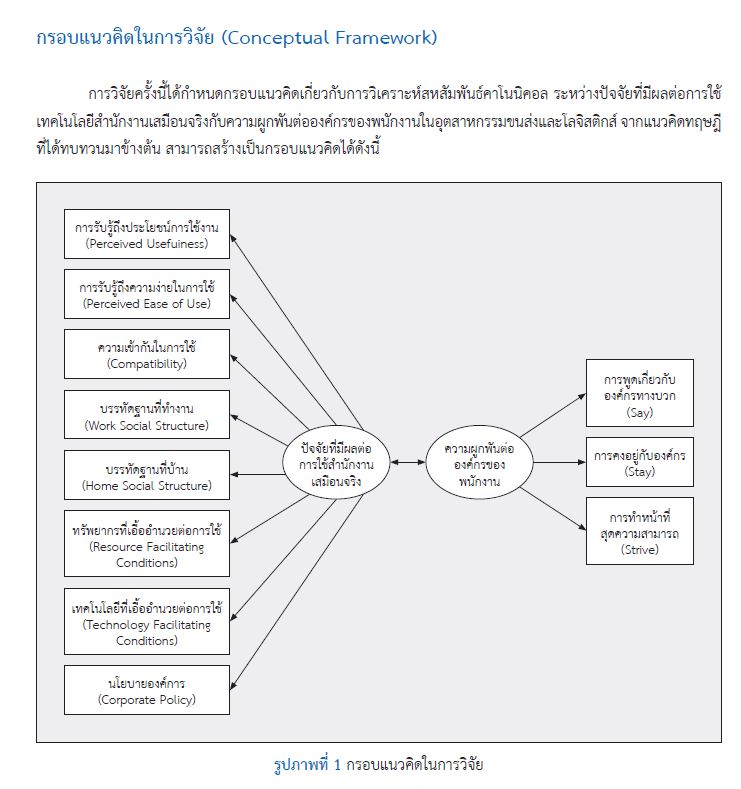The Canonical Correlation Analysis between Factors Affecting The Using of Virtual Office Technology and Employee Engagement in The Transport and Logistics Industry
Keywords:
Canonical, virtual office, telework, remote work, employee engagementAbstract
This research aims to study the canonical relationship between factors affecting the using of virtual office technology and employee engagement in the transportation and logistics industry. The 400 sample were selected from employees working in the transport and logistics industries whom working under virtual office policies in Bangkok and its vicinity by convenient sampling method. The authors, questionnaires were used to collect the data which analyze by using descriptive statistics as frequency, percentage, mean, standard deviation and the canonical correlation analysis.
The results showed that the factors affecting the use of virtual office technology were very high correlated with the organizational engagement of employees in the transportation and logistics industry (canonical coefficient of .727). Factors affecting the use of virtual office technology canonical weight was between .538 and .811, with the sample most concerned about Perceived of ease of use. The factor of organizational engagement of personnel has a canonical weight between .564 - .764, with the sample focusing most on Stay with the organization. In conclusion, in order to implementing the policy of using virtual office technology in the organization. Executives need to take into account the ease of using information technology in the operation of personnel, facilities and resources that will enable personnel to complete their assigned tasks effectively. Therefore, employees should embrace the technology as a tool that supports their job performance, creates job satisfaction and ultimately leads to employee engagement with the organization.
References
Ajzen, I. (1985). From Intentions to Actions: A Theory of Planned Behavior. Springer: Heidelberg.https://doi.org/10.1007/978-3-642-69746-3_2
Ajzen, I. (1991). The theory of planned behavior. Organizational Behavior and Human Decision Processes, 50(2), 179–211. https://doi.org/10.1016/0749-5978(91)90020-T
Ajzen, I. (2002). Perceived behavioral control, self-efficacy, locus of control, and the theory of planned behavior. Journal of Applied Social Psychology, 32(4), 665–683. https://doi.org/10.1111/j.1559-1816.2002.tb00236.x
Blaique, L., & Pinnington, A. (2023). Virtual work challenges and opportunities in the Asia-Pacific region: the role of organizational virtual work climate. Elgar Companion to Managing People Across the Asia-Pacific, 269-288. https://doi.org/10.4337/9781802202250.00023
Clark II, S. D., & Olfman, L. (1999). Influencing the decision to telework—testing the simplified decision model. In Proceedings of the 1999 ACM SIGCPRconference on Computer personnel research, 65-72. https://doi.org/10.1145/299513.299618
Cochran, W. G. (1953). Sampling Techniques. New York: John Wiley & Sons.Grant.
Grant, C.A., Wallace, L.M., Spurgeon, P.C., Tramontano, C. & Charalampous, M. (2019). Construction and initial validation of the E-Work Life Scale to measure remote e-working. Employee Relations, 41(1), 16-33.https://doi.org/10.1108/ER-09-2017-0229
Debbie, D. D., & Carol, M. L. (2016). Managing Virtual Teams. New York: Business Expert Press, LLC.
Haines, V. Y. III, St-Onge, S., & Archambault, M. (2002). Environmental and person antecedents of telecommuting outcomes. Journal of Organizational and End User Computing, 14(3), 32–50.https://doi.org/10.4018/joeuc.2002070103
Harunavamwe, M. & Kanengoni, H. (2023), Hybrid and virtual work settings; the interaction between technostress, perceived organizational support, work-family conflict and the impact on work engagement. African Journal of Economic and Management Studies. https://doi.org/10.1108/AJEMS-07-2022-0306
Igbaria, M., & Guimaraes, T. (1999). Exploring Differences in Employee Turnover Intentions and Its Determinants Among Telecommuters and Non-Telecommuters. Journal of management Information Systems, 16(1), 147-164. https://doi.org/10.1080/07421222.1999.11518237
Johansen, B. & Euchner, J. (2013), Conversations: navigating the VUCA world: an interview with Bob Johansen. Research-Technology Management, 56(1), 10-15. https://doi.org/10.5437/08956308X5601003
Lubowiecki-Vikuk, A., Budzanowska-Drzewiecka, M., Borzyszkowski, J. & Taheri, B. (2023). Critical reflection on VUCA in tourism and hospitality marketing activities. International Journal of Contemporary Hospitality Management, 35(8), 2983-3005. https://doi.org/10.1108/IJCHM-04-2022-0479
Maharani, A. (2024). Back to Work or Remote Work: Trends and Challenges. Business and Management in Asia: Disruption and Change, 139-150. https://doi.org/10.1007/978-981-99-9371-0_9
Mann, S., & Holdsworth, L. (2003). The Psychological Impact of Teleworking: Stress, Emotions and Health.
New technology, work and employment, 18(3), 196-211. https://doi.org/10.1111/1468-005X.00121
Mello, J. A. (2007). Managing Telework Programs Effectively. Employee Responsibilities and Rights Journal, 19(4), 247–261. https://doi.org/10.1007/s10672-007-9051-1
Mathasit Tanyarattanasrisakul. (2016). The Canonical Correlation Analysis for Educational Mathematics. Mathematical Journal by The Mathematical Association of Thailand Under the Patronage of His Majesty the King, 61(690), 13 -26.
Marketeer Magazine. (2021). The parcel delivery market is growing, each brand must adjust their strategies to speed up and escape competitors in terms of both price and speed. from URL Address https://marketeeronline.co/archives/222852.
Nilles, J. M. (1988). Traffic Reduction by Telecommuting: A Status Review and Selected Bibliography. Transportation Research Part A: General, 22(4), 301–317. https://doi.org/10.1016/0191-2607(88)90008-8
Olsen, K.M., Hildrum, J., Kummen, K. & Leirdal, C. (2023). How do young employees perceive stress and job engagement while working from home? Evidence from a telecom operator during COVID-19. Employee Relations, 45(3), 762-775. https://doi.org/10.1108/ER-05-2022-0230
Sherry, A. & Henson, R. K. (2005). Conducting and Interpreting Canonical Correlation Analysis in Personality Research: A User-Friendly Primer. Journal of Personality Assessment, 84(1), 37-48.https://doi.org/10.1207/s15327752jpa8401_09
Schutz, D.P., & Schutz, S.E. (1994). Psychology and Work Today: An Introduction to Industrial and Organization Psychology. Macmillan.
Sparrow, P. (2000). New employee behaviours, work designs and form of work organization: what is in store for the future of work?. Journal of managerial, 15, 202-218.https://doi.org/10.1108/02683940010320561
Steers, R. M. (1977). Organization Effectiveness. California: Goodyear Publishers Inc.

Downloads
Published
How to Cite
Issue
Section
License
Copyright (c) 2024 NIDA Business School, National Institute of Development Administration

This work is licensed under a Creative Commons Attribution-NonCommercial-NoDerivatives 4.0 International License.



